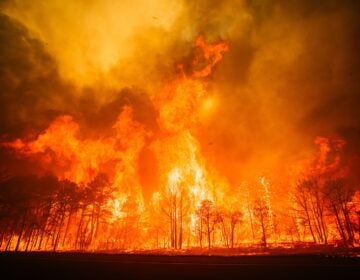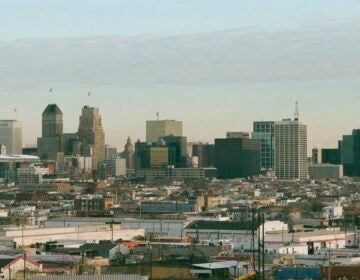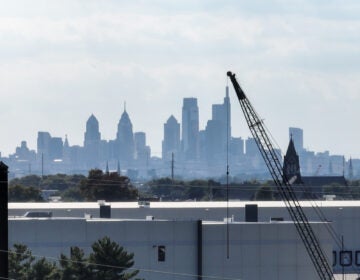How did the Jones Road wildfire start and why are wildfires common in the New Jersey Pine Barrens?
The large wildfire was sparked at the peak of New Jersey’s spring fire season.

The Jones Road wildfire, which has impacted Ocean and Lacey townships in Ocean County, burns in New Jersey. (Courtesy of New Jersey Department of Environmental Protection)
From Camden and Cherry Hill to Trenton and the Jersey Shore, what about life in New Jersey do you want WHYY News to cover? Let us know.
The Jones Road wildfire which, as of 4 p.m. Friday, engulfed 15,300 acres, was reported by a spotter in the Cedar Bridge Fire Tower at around 9:45 a.m. Tuesday. At that time, the flames fanned across 10–20 acres. Trevor Raynor, a division forest fire warden with the New Jersey Forest Fire Service, said despite “a big show of force to contain the fire,” which included dispatching aircraft, the fire grew.
“Our initial attack efforts failed because of extreme fire behavior, dry, droughty fuels, spring fire season, windy, low [relative humidity,]” he said.
At one point, the blaze burned past the Garden State Parkway and reached Route 9. Both of the major highways had closed late Tuesday through Wednesday morning. More than 24 hours after the initial report, the fire had consumed more than 11,000 acres and was about a third of the way contained.
Ocean County Prosecutor Bradley D. Billhimer said he is confident that 19-year-old Joseph Kling started the fire, but did not disclose whether it was the result of a bonfire or criminal mischief. Kling was arrested Wednesday and is being held at the Ocean County Jail.

Jones Road wildfire could rival a blaze from 2007
New Jersey Environmental Protection Commissioner Shawn LaTourette said Wednesday that he expected the Jones Road wildfire to be the largest one in the state in nearly 20 years.
On May 15, 2007, an F-16 on a training mission from an Atlantic City airbase dropped a flare at the Warren Grove Gunnery Range in Ocean County. William J. Donnelly, chief of the state Forest Fire Service, said the flare torched more than 17,000 acres.
New Jersey recorded twice as many wildfires in 2025, to date
As of Wednesday, Donnelly said there have been 662 wildfires since the start of the year with 16,572 acres burned. For the same period in 2024, there were 310 wildfires that engulfed 315 acres. Historically, April 20 is the peak of the spring fire season.
Last year, above-average rainfall kept the spring fire season calm. However, New Jersey remains in “drought warning” status. In addition to the ongoing dry spell, low humidity and winds, fighting this fire has been more difficult, according to fire warden Raynor.
Dr. Matthew Aiello-Lammens, an ecologist and associate professor of environmental studies and sciences at Pace University, said dry conditions provide more dry material to burn.
“The drier the material, the faster it’ll burn and the more easily it’ll burn,” he said, adding that you also have to factor in wind conditions. ”High winds will cause fires to spread rapidly, and in some cases, increase the severity of the fires as well.”
Overall, experts say climate change is factoring into longer fire seasons in the Garden State. State officials have said they are starting to fight fires as soon as mid-February and are continuing to fight them into early July. Research from Climate Central found North Jersey and the coastal area of New York have added around 10 days of fire weather since 1973, while South Jersey added around four days.
Forest fires are common in the Pine Barrens
According to the Pinelands Preservation Alliance, wildfires have shaped the ecosystem of the Pine Barrens for thousands of years.
Aiello-Lammens said the ecosystem requires fire to be at its healthiest, noting one of the main tools to manage the forest is prescribed burning.
“There are actually quite a few plants that require fire for healthy growth and reproduction,” he said, adding that the pitch pine benefits the most from fires.
“Some pitch pine actually require fire for them to release their seeds from these cones that are protected from fire,” he said. “Immediately after the fire is over, they’ll release their seeds onto this barren ground, which allows the seeds to have the opportunity to grow.”
What’s the impact of the Jones Road wildfire?
Regardless of how the fire began, its aftereffects are the same.
The land is going to look “like a pretty barren landscape” for the next several months, according to Aiello-Lammens. Then, as summer transitions into the growing season, other plants will start to return.
“It will probably look a little like a moonscape over the next couple of weeks, and then as the growth comes back, you’ll start seeing the early signs of a pitch pine barren forest.”
How can humans prevent causing wildfires?
State officials have said wildfires are nearly completely preventable. They’ve urged people to be careful with their cooking grills, their campfires and when cleaning out their chimneys. They also urge residents to have a plan to be ready when a fire breaks out.
More tips can be found on the state forest fire service’s website, njwildfire.org.

Get daily updates from WHYY News!
WHYY is your source for fact-based, in-depth journalism and information. As a nonprofit organization, we rely on financial support from readers like you. Please give today.






